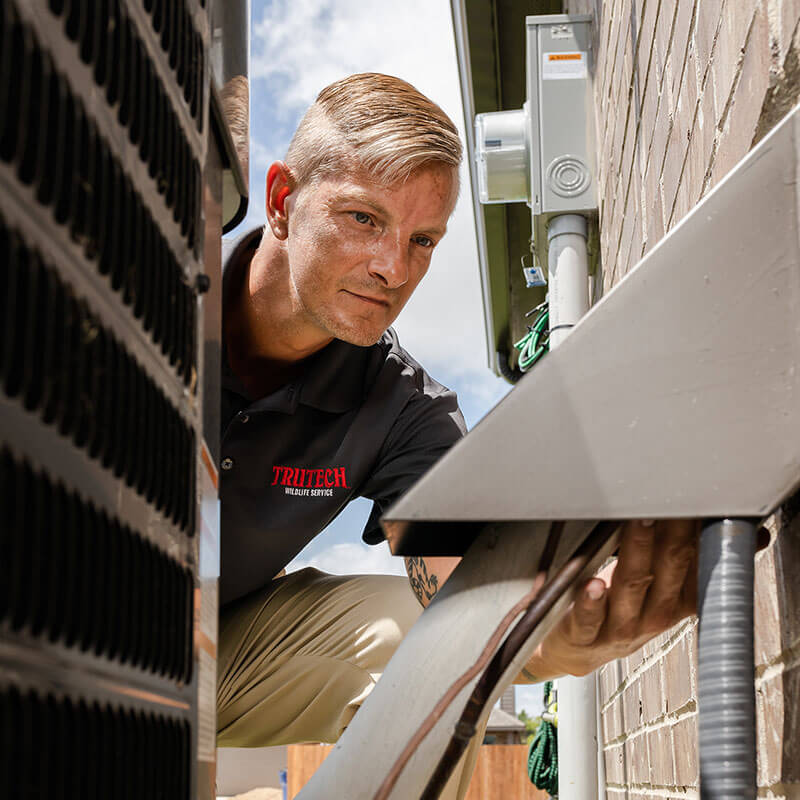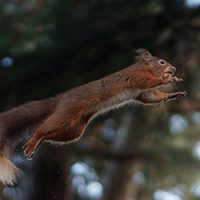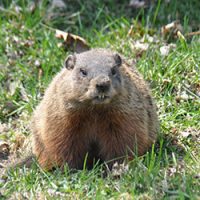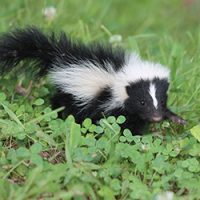Waynesville Wildlife Removal
Some Geographic Restrictions
Wildlife We Remove in Waynesville, NC
Nestled between the Great Smoky Mountains National Park and the Nantahala National Forest, Western North Carolina is a magnet for outdoor enthusiasts and home to over 400 vertebrate species. One of the few rainforests in the contiguous 48 states, the Appalachian temperate rain forest has over 100,000 acres of unspoiled wildlands and over 90,000 acres of old-growth forests.
Most wildlife in Western North Carolina avoid humans, but buildings provide food and shelter. Wildlife in your home is not safe for you or the animal. Trutech provides humane and effective solutions to remove the animal from your home and property.
Common Nuisance Wildlife in WNC
Other Wildlife
Waynesville Wildlife Removal Services
Typical wildlife affecting homes in Haywood, Transylvania, Jackson, Clay, and Cherokee are typically the animals you would find in the national forests. Animals have the same basic needs as humans– food, water, and shelter. They enter a home looking for resources to satisfying those basic needs. Some of the most common nuisance wildlife in Wester North Carolina are raccoons, bats, woodpeckers, rodents, squirrels, flying squirrels, and snakes.
Step 1: Inspection
Our comprehensive wildlife removal process starts with a whole home inspection. We start the inspection by asking questions so we can understand exactly what you’re experiencing. We want to address any signs of wildlife you have noticed like hearing strange sounds or smelling unusual odors.
When a Trutech technician arrives at your home, we will start by asking questions about your experience with the nuisance wildlife at hand.
Once we have a firm grasp on the issues the property owner is facing, a thorough inspection of the interior and exterior of the home begins. This includes looking at the attic, crawlspace, roof, and any possible entry points. Since each species and home is different, the length of the inspection can vary. It can take between 30 minutes to 3 hours to accurately evaluate the extent of the wildlife nuisance issue.
Step 2: The Plan
With the results of the inspection, we share our findings with you. And share how we will solve the problem for you.
Although each wildlife control plan is unique to the home, it may include live trapping, direct capture, one-way doors, or deterrents. Before any work begins, we make sure that you are comfortable with the steps being taken to resolve the nuisance wildlife issue.
Step 3: Get To Work
If you approve of the plan, we will set up a time to put it into place. After the animal removal has taken place, we will repair any damage caused by the critter. Additionally, we will apply sanitizing and ectoparasite agents to the affected areas. Once the plan is executed, your home will be returned to its normal condition.
Step 4: Full Home Exclusion
Wildlife removal is just one part of the plan. Many plans include wildlife control measures to prevent any future problems. This is often completed by installing a full home exclusion. The goal is to create physical barriers to prevent animals from entering your home in the future.
A few possible exclusion techniques include gable vents, ridge vents, crawlspace vents, roof returns, and plumbing stacks. With the appropriate exclusions in place, you can rest easy knowing that a long-term solution is in place to protect your home from nuisance wildlife.
Guarantee and Warranty
Once installed, Trutech offers a one-year warranty on full home exclusions. Plus, there is a 100% satisfaction guarantee. If you aren’t satisfied with the initial work, Trutech will send out a service manager to inspect the work completed and make any necessary adjustments.

Some Geographic Restrictions
Common Wildlife in Waynesville
Raccoon
Raccoons inhabit all parts of the state, tend to stay near a reliable source of water, and are comfortable in urban areas. Raccoons can wreak havoc trying to gain entry to your home and cause significant damage creating a den in your attic. They can cause a mess of garbage and destroy home gardens and birdfeeders. Because they are nocturnal, you’ll most likely hear a loud thumbing at night if you have an attic.
Live trapping is the most common removal technique and exclusion techniques include securing food sources and closing any entry points.
Squirrel
Squirrels nest in attics and vents if they’re able to access the home. You’re most likely to hear a squirrel family in your home in early spring and early fall.
Squirrels are active during the day so you might hear squealing, running, or gnawing early in the morning. Squirrels’ teeth never stop growing so they constantly gnaw and chew damaging attic insulation, fraying electrical wire, and destroying house structures.
Squirrels can impact your quality of life. They are active from dawn to dusk. The most common sign of squirrels is the sound of scurrying early in the morning.
Bat
Bats in the attic, or elsewhere in your home, can be a particularly troublesome nuisance. Not only do they make a lot of noise, but their nests and droppings can negatively affect your health and the health of your family.
Bat guano is the surest sign you have bats and the greatest risk to your health. A large accumulation of guano can lead to structural issues and spread two fungal diseases.
Who We Are
When you encounter unwanted wildlife in your home or business it is important to resolve the problem quickly and professionally. At Trutech®, our expert technicians and specialists have over 100 years of combined experience in the wildlife removal industry.
We know how to protect you and your family from the hazards of wildlife in your home or place of business.
Some Geographic Restrictions


Frequently Asked Questions
There is no one-size-fits-all solution; each job requires a custom approach. We inspect every home and build a custom plan to resolve any wildlife problems. We use a variety of techniques including cage traps, direct capture, one-way valves, and deterrents. Exclusion techniques are the most effective way to get rid of animals.
We provide customized solutions to each individual customer so that we may solve the issue as quickly, efficiently, and cost-effectively as possible. The size of the house, type of animal, number of nuisance animals, and length of time of infestation affect the estimated price of wildlife removal.
An estimate may change based on the amount of animal activity or work needed to be done. All estimates are finalized with an exact price before any work begins.
Our goal is to remove any wildlife as humanely as possible — often that means catching and releasing the animal.
Trutech® does not hire subcontractors for animal removal services. We employ expert technicians who are provided ongoing education and training in all aspects of animal control and removal. Many of our technicians hold degrees in Wildlife Biology, Entomology (insects), Ornithology (birds) or Herpetology (reptiles), some with Masters degrees in their specialty field.
Yes! We are licensed and insured.
We start by first removing the wildlife on your property, and cleaning up any damage. From there we’ll work with you to create a customized prevention plan so you won’t have the same issue again.
Typically an animal dies in your home because it became trapped in a hard-to-reach and hidden area. Our expert technicians have the experience and knowledge to find it and then safely remove the carcass from your home.
Our Wildlife Technicians use a pet-safe odor eliminator made of natural organisms and enzymes that consume decaying organic odor-causing matter, eliminating the source of the lingering odor. We use aerosols, oxidizing agents, foggers, and disinfectants with germicides to deodorize until nature completes this task for you.
You should consider a full home exclusion after the smell has been neutralized. Nuisance wildlife found its way into your house once. That entrance leaves your home vulnerable to future animal infestations. Full home exclusions are the most effective form of wildlife control.








